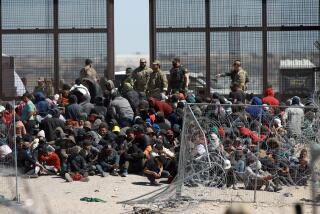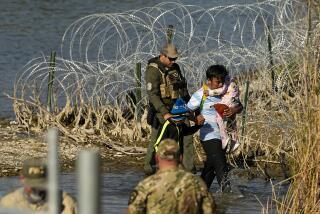Border authorities fear immigration action might spark second ‘surge’

Homeland Security Secretary Jeh Johnson warned would-be migrants Friday that President Obama’s action to defer deportations was not an endorsement of illegal immigration, and he pledged to beef up already tight security on the U.S.-Mexico border.
“Unless you qualify for some form of humanitarian relief, for asylum, we will send you back,” Johnson said as he stood outside the Border Patrol station here. “A recent arrival is a priority for removal, and again I want to stress that, because there should not be any misunderstanding or misinformation about our new policies: Our new policies are not for those who are recently here illegally or who are contemplating coming here illegally.”
Still, some law enforcement officials in south Texas worry that Obama’s action will be misconstrued and prompt another wave of illegal immigration.
Don Reay, executive director of the Texas Border Sheriffs’ Coalition, has been watching Spanish language news reports about the president’s announcement with growing concern — they seem already to be celebrating a blanket amnesty, he said.
“I am afraid some people in other countries will read it as that because of the hype,” Reay said.
Obama’s executive directive would not give people “legal status” or provide a path to citizenship, though it would defer deportation for millions living in the country illegally.
Though illegal immigration has been on the decline, a wave of children and families overwhelmed immigration authorities over the last year. More than 68,000 unaccompanied children entered the country illegally, almost twice the number the previous year.
The surge that occurred over the summer was driven, in part, by a rumor that the U.S. government would allow children or families with children to stay in the U.S. indefinitely. The rumor circulated throughout Central America and, though false, prompted thousands to travel north in hopes of obtaining a permiso, or permission, to remain in the United States.
The increased security prompted by the surge is easily visible here.
In response, the Border Patrol sent 300 agents to help the 3,100 based in the Rio Grande Valley. Texas Gov. announced an emergency state border surge of added staff and resources (extended this week through next summer) and deployed the National Guard to assist.
This week, Greg Abbott — now governor-elect — vowed to challenge Obama’s “dictatorial” immigration policy in court.
Some decry the effect of increased security on life along the border.
“When you militarize a piece of American soil it has consequences, and the first consequence is the rights of the people who live there,” said Fernando Garcia, executive director of the Border Network for Human Rights, noting the number of Border Patrol agents doubled from 2004 to 2012, and now employs more than 21,000.
During the summer increase in immigration here, Border Patrol agents in the Rio Grande Valley were apprehending about 2,000 people a day; now they catch about 400, a spokesman said Friday.
Johnson noted that the number of unaccompanied children immigrating into the Rio Grande Valley region had “declined dramatically,” and was now lower than it’s been in almost two years, 20% lower than it was last year before the swell in numbers.
The increased security prompted by the surge is easily visible here.
Riverfront Anzalduas Park in nearby Mission has been transformed from a 96-acre smuggling hot spot to a virtual command post.
Hidalgo County Precinct 3 Constable Lazaro “Larry” Gallardo pointed out law enforcement vehicles as he drove into the park Thursday afternoon: a National Guard Humvee, Border Patrol SUV and a dozen state troopers parked near a ramp where a gun boat had just departed to patrol the river.
Smugglers used to ferry people across from the opposite bank on jet skis, but they started thinking twice after troopers intervened, confiscating one of the watercraft.
“Any action today?” Gallardo radioed one of his deputies patrolling the park in a marked pickup.
“Not to my knowledge,” the deputy replied. “I think they got one today — it’s been slow.”
Nearby, a half-dozen bird watchers with binoculars strolled across the grass toward a stand of trees while a man on the riverbank set up a folding chair to fish.
Gallardo pulled onto a wooded dirt road that runs along the river. This summer, women and children would emerge from the bushes to turn themselves in, assuming they would be granted permisos. The grass would be strewn with their detritus — water bottles, litter and clothing.
“This is where they were coming across, lining themselves up,” he recalled.
Now there was no sign of them.
The constable slowed as he approached another National Guard Humvee, greeting the three uniformed troopers stationed on a rise overlooking a dam. On the opposite bank, where smugglers’ cars used to circle, two men were fishing. Ducks skittered on the rocks under overcast skies. Otherwise, all was silent.
The constable climbed out, pointing to a trail of matted grass near the river.
“They were coming up from over there,” he said.
Smugglers are still sending drugs and immigrants across, and authorities still catch some Central American women and children who turn themselves in, perhaps a couple a day in the park.
“There’s no longer a crisis. It’s the normal stuff we’ve been dealing with for years,” Gallardo said.
Those that cross now are mostly using rafts, wary of the chilly water. Normally, as winter approaches even fewer immigrants cross the river, the constable said. But he worries the president’s announcement could trigger a new influx.
“It could be a flood again, a surge. And then we’re dealing with hundreds a day and the facilities — there’s not enough room for them,” he said of local Border Patrol holding areas, where immigrants are held before they’re transferred to detention centers.
The federal government responded to this year’s surge with new facilities. An immigrant detention center built to house up to 2,400 women and children is slated to open next month about 230 miles northwest in Dilley. And that center is about 90 miles west of another new center. Officials announced this week that they plan to close a third in Artesia, N.M., and shift immigrants in the country illegally to the two facilities in Texas.
“These facilities help ensure timely and effective removals that comply with our legal and international obligations, while deterring others from taking the dangerous journey and illegally crossing into the United States,” said Acting ICE Director Thomas S. Winkowski in a statement this week. He appeared with Johnson in McAllen on Friday.
About 75 miles north of the border near a Border Patrol checkpoint in Brooks County, ranchers worried this week that threats to crack down on criminals who immigrated illegally won’t be enough to stave off a new wave of immigrants.
“If you have selective deportation and people feel they can get through because they’re not a criminal, you just have this unending cycle of influx,” said Susan Kibbe, executive director of South Texans’ Property Rights Assn. based in the county seat of Falfurrias, near the checkpoint.
Immigrants who make it this far often get lost, stranded and die on the vast ranchland. So far this year, 58 bodies have been found. Deputies and volunteers believe many more remain undiscovered in the brush. As part of the state surge, some National Guard troops were recently sent to help locate immigrants’ remains.
Eddie Canales, an organizer with the Falfurrias-based South Texas Human Rights Center, called the president’s plan a “band-aid” that failed to deal with the root causes of migration in the region and would likely result in more immigrants getting caught and deported - without stopping the flow.
Added enforcement will simply force smugglers and migrants to take more dangerous routes, he said, and, “We’re going to have more deaths if we’re not proactive.”
Follow @mollyhf for news from Texas and across the nation.
More to Read
Start your day right
Sign up for Essential California for news, features and recommendations from the L.A. Times and beyond in your inbox six days a week.
You may occasionally receive promotional content from the Los Angeles Times.







